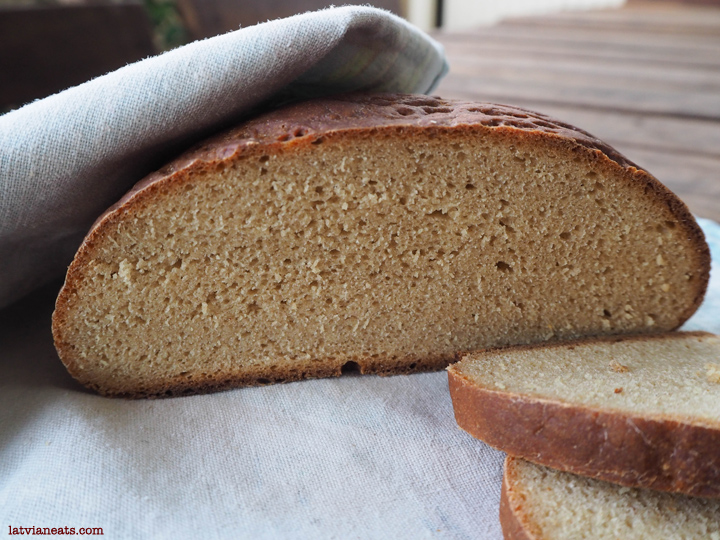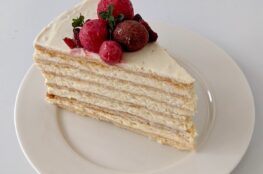Rye bread (rupjmaize, rudzu maize) always has been a staple of Latvian diet. Traditionally, Latvians ate whatever was available during the season – cereals, legumes and root vegetables, meat and dairy. Rye and barley was available all year round thus becoming the most important source of subsistence (wheat was considered to be a delicacy). It was believed that while there was rye bread on the table, no one would go hungry.
Rye has been grown in Latvia for more than 1200 years, and rye bread became common more than a thousand years ago. Similarly to Scandinavian and Slavic traditions, rye bread was baked from leavened dough and it was considered to more nutritious and tastier than barley bread. In late 19th century sourdough bread gained popularity, but it was mainly baked for celebrations as it was more time consuming.
Rye bread was eaten at every meal, however, it was not served with porridge (another staple). Good bread was the pride and joy of every hostess and no effort was spared when baking the bread. During the harvest, the owner of the house would bake the first batch of bread to check the quality of new flour, how well it rises and sticks. The sower of rye would be offered the first bite of the bread to celebrate his effort, only then the baker and the rest of the family would eat.
Other, still observed, customs dictate:
– If the bread is accidentally dropped, it must be immediately picked up and kissed.
– Do not wipe breadcrumbs on the floor, otherwise God will not place more bread on the table.
– Do not place the bread bottom side up, otherwise the family will experience hunger.
The recipe of rye bread presented here is one of three recipes I tried to see if it is possible to skip 120km round trip to the only shop in town that sells proper rye bread and bake my own at home. From all three recipes this was the easiest and least time consuming (borrowed from here). Baked loaves may appear lighter in colour than usual as the flour was very fine and I did not have malt extract to replace the sugar (malt extract gives darker colour), but the taste was just as good.
Ingredients
- 750g rye flour
- 600ml buttermilk
- 80ml apple juice
- 4 tbs sugar
- 1 tbs salt
- 1 heaped teaspoon instant yeast
- caraway seeds (optional)
Instructions
- Warm the buttermilk to blood warm temperature (test by putting couple drops on the inside of the wrist - it should not burn).
- In a large bowl mix all dry ingredients together and add all liquids. Mix well. The dough will become very thick. Continue by kneading the dough in the bowl or on a kitchen bench for 15 minutes. The dough will be slightly sticky.
- Place the dough back in the bowl and flatten the dough with wet hands.
- Cover the bowl with a tea towel and place in a warm spot (above 25 degrees Celsius) to rise for 1-2 hours.
- Preheat the oven to 250 degrees Celsius. Line a baking tray with baking paper or lightly oil the pan.
- When the dough has risen, wet your hands and split the dough in half to create two loafs. Place both loaves on the pan and let them rise for 30 minutes. When dough has risen, brush both loaves with cold water.
- Place the tray in the oven and bake in 250 degrees for 10 minutes, then reduce the temperature to 180 degrees and bake for additional 25 minutes.






August 9, 2015
I find that I have to add quite a bit more flour just to be able to unstick the dough from my hands as I’m kneading – is this normal?
August 9, 2015
I find this recipe different from most dough recipes, e.g., piragi dough. I have made the bread with this recipe several times and I do not add any flour to “unstick” the dough. It is awfully sticky with this amount of flour, but I just scrape it off my hands. Bread turns out just like it is meant to be.
June 30, 2023
I am going to try this recipe very soon! Not only do I want to taste the bread, but if part of it goes stale, I’ll be making kvass. Three nieces and I fell in love with the stuff in Latvia. BTW, I have started at my age using the bread machine (even my cheap West Bend model has two paddles in it) on the “risen dough” cycle. All the ingredients go into the machine, it does its magic for 90 minutes or so, and then it’s time for shaping and the final rising (about an hour) under a damp cloth before it goes into the hot oven. Gives a dependable result every time.
One question though- may I use kefir instead of buttermilk?
May 2, 2019
I’ve learnt a trick that prevents dough sticking to hands: put some vegetable/olive oil on your hands. Then dough won’t stick and you’ll need more efficiently.
December 31, 2015
You got a recipe for a sour Latvian rye sourdough??? My mum’s friend used to make a very dark sourdough that was lip puckering tangy, and I loved it. She died many years ago, and I have been unable to replicate it.
February 7, 2020
https://www.bigoven.com/recipe/latvian-sourdough-rye-bread-saldskaaba-maize/105148
February 7, 2016
How many cups of flour is that? 3 cups seems to make it still runny.
February 13, 2016
It is around 6 cups of flour.
November 9, 2016
750g equals about 3.17 cups? Is it 3 or 6. Big difference!
November 13, 2016
I’d go with 6 cups of flour.
February 14, 2016
Thanks – I eyeballed it, and it’s delicious!!
December 27, 2016
Hi there! I also love Latvian rye bread, so I’m glad I’ve found your blog. I have managed to find malt extract. I would like to know whether I should replace then the 4 tbs sugar for 4 tbs malt extract?
December 29, 2016
Honey or molasses may be a better substitute, it will also add some colour to the bread
April 16, 2017
Hi there! Me again… I’ve managed to bake the Latvian rye bread following your recipe. However, the loaf turns out a bit flat. I bake it on an oven tray with baking paper. How have you baked yours (the one shown in the photo)?
By the way, do you happen to have/know any recipe to make a Latvian rye bread with fruits? See here, for example: http://newyork.seriouseats.com/images/20120101-190914-goodbread-storye-fruitnuts.jpg
Thanks for sharing your recipes. I really enjoy them!
May 8, 2017
My guess would be that there is an issue with yeast. Yeast needs to be fresh, I’ve found on occasions that it does not perform that well after a while, e.g., if stored incorrectly. It may also be that the buttermilk was too hot and it killed the yeast.
August 27, 2017
Looking for a recipe for Klinger which is probably not the accurate spelling….kinda like a coffee cake….. can anyone help???
August 31, 2017
[…] the importance of Rye Bread in Latvian […]
December 21, 2018
This bread was flat fresh yeast I think it needs more yeast how many ounces is buttermilk
December 23, 2018
600ml should be 20.3 fluid ounces. This bread is quite dense and will not come out fluffy and light, but you could add more yeast and see what happens
November 19, 2019
[…] https://latvianeats.com/archives/264 […]
April 9, 2020
I made this bread with all purpose flour as a “test” and it was delicious! Obviously not saldskabmaize but really good nevertheless.
When I later made it using the rye flour, like stated in an earlier comment, the dough was extremely thin and the bread did not turn out well. Very flat. Perhaps with the rye flour – at least the type we get in the grocery in the US – it should be closer to the 6 cups.
November 16, 2020
[…] L., “Rye Bread,” Latvian Eats, 23-Jan-2015. [Online]. Available: https://latvianeats.com/archives/264. [Accessed: […]
February 18, 2021
[…] Ingredienti – 2 pagnotte – pane integrale ( di segale ) […]
March 18, 2024
Do you need a special type of rye flour for this bread, or is what most US stores carry ok?
July 6, 2024
I am based in Australia – I use whatever rye flour I can find in supermarkets or markets.